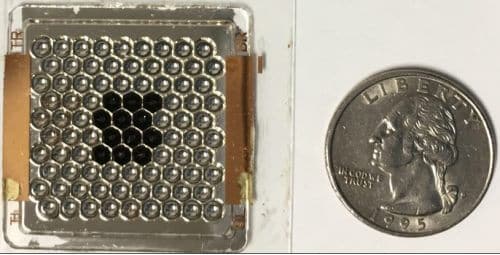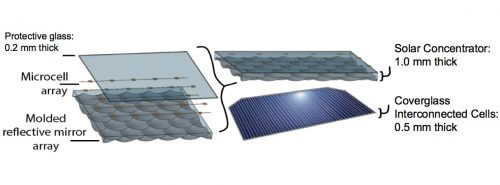The tiny system developed by Prof. Jeffrey Gordon for utilizing solar energy in space will be launched for a series of tests under precise conditions on the International Space Station in early 2020

A miniature prototype of a solar generator developed at Ben-Gurion University will be launched by the space agency NASA to the International Space Station in 2020. The innovative device for producing electricity from sunlight is the product of development by Prof. (Emeritus) Jeffrey Gordon from the Department of Solar Energy and Environmental Physics at the Blaustein Desert Research Institute and his partners from the USA, and is an important step towards private commercial space flights. The development and experiments were published in the latest edition of the prestigious journal Optics Express. The research is funded by a grant from the Ministry of Science and Technology.
Space missions are not a complex matter for military or government bodies with large budgets. However, for commercial and private entities the cost involved is of utmost importance. Especially since private space corporations have significantly reduced launch costs, so solar energy systems now make up a larger portion of the system cost. Since the private space market has grown at an enormous speed and has become an entire industry that turns over a billion dollars a year and includes dozens of corporations, the need to invent and implement innovative and workable solar solutions arises. The application of miniaturized solar devices, which can improve the production of specific electrical power (watts per kilogram) at an affordable price, can meet this need.

The developed prototype features a compact, low-mass solar center made of cast glass and directly coupled to printed solar cells, each composed of several different materials that together efficiently utilize most of the solar spectrum. The prototype is so thin that its total thickness is only 1.7 mm, with the thickness of the solar cells attached to its sides 0.65 mm. A notable advantage of the device is its optical tolerance to errors in the orientation of the cells to the sun, structural vibrations and thermal distortion, while delivering specific electrical power intended for the task with unprecedented efficiency.
The space agency NASA has decided to attach the prototype for its first launch in 2020 to the International Space Station so that they can test the effect of cosmic radiation and huge temperature differences during the transition outside the Earth. The team is currently working on the development of the second generation that can increase the supply of specific electrical power even more and is based on more efficient solar cells, developed at the US Navy Laboratory, with a thickness of only 0.17 mm (for comparison, the thickness of paper is 0.10 mm). Since the dimensions of the sunlight center depend on the size of the cell, the second generation assembly will be less than 1.0 mm thick.
After verifying the integrity of the material and stability in working conditions in space, the device is expected to be used not only in private missions but also in missions of space agencies in deep space that require high electrical power for electric propulsion (for example in missions to Jupiter and Saturn).

4 תגובות
Hi Guy, I have known Prof. Gef Gordon and his works and research for about 25 years,
Unfortunately, I am familiar with the development and technology that Gordon is working on, which is called in the professional language
cascade cell
It is not new and has been tried in the past and it is clearly not economical
The problem is that researchers and not industrialists, their unstated goal is to continue researching and never reach a finished industrial product. To continue to attract research funds from the university and the state, and in this case in cooperation agreements with the Americans who pay us the equivalent of dollars in their agreement to put into space an experiment that will not bring or contribute anything to anything.
It's not for nothing that the price of Luoat is not indicated in this scientific article that was published already a month ago in Energy News, including my comments
The cascade basket is an attempt to put solar cells made of different materials on top of each other, each receiving a different band gap (range of wavelengths) and thus increasing the range of the spectrum that the integrated cell responds to, that is, if a normal poly or monocrystalline cell is active between wavelengths of 300 to 370 nanometers meter of visible light and emits approximately 1.4 electron volts per square cm. If we put a gallium arsenide cell on it, it will add another active wavelength between 370 and 450 nanometers, and if we add an amorphous silicon cell above it, it will add almost up to 700 nanometers, which is the beginning of the infrared. And so the integrated cell will respond to a wider spectrum of light - this is physically true
But it is not economically correct. The combined cells come out very thick
Instead of 280 microns thickness, a thickness of half a cm up to 1.5 millimeters is obtained
The business is expensive, heavy and uneconomical!
Normal cells of monocrystalline and polycrystalline, their thickness is 150-300 microns, the size is 6-8 inches (not a coin) and the efficiency is 20 percent
At the price of 20 cents!
Five times cheaper than Gordon's cell and one and a half times more efficient
Nir
Don't be a troll.
Another space scam from NASA... only lies from the moon landing lie... when will they realize that space is a scam and not real?
Cell utilization was not specified. What about the utilization of advanced photoelectric cells over the KDA?